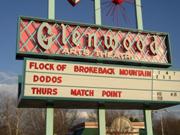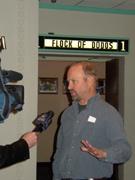<blogentry><entrydate month='02' time='14:00' daynum='1' day='02' year='2006'/> Day 1: Arrival

From the air, Kansas is very flat, brown, and, well, bland. But the first people to greet me at the rental car desk are quite pleasant and full of color. When I tell them what brings me to Kansas, they react by slapping their foreheads and shaking their heads. Or nodding and saying, "Yes, that's a real hot-button issue here." It seems Kansans fall into two categories-those who are embarrassed that Kansas makes the news for supporting intelligent design and those who feel very strongly about the debate.
And Kansas does indeed make the news. In 2005 the Kansas State Board of Education adopted teaching standards that support intelligent design - the idea that an intelligent creator must have shaped the course of evolution (for more, see the news@nature.com "focus":http://www.nature.com/news/infocus/religionandscience.html on religion and science.). This has left many wondering why so many people in Kansas seem intent on bringing religion into the science class.
While making my way through downtown I run into a road detour and end up in the wrong lane. A gentleman in a large red pickup truck kindly waved me ahead of him. If I'd been in Denver, he would have tried to run me down. I've only been in the state for 30 minutes and already four people have gone out of their way to help me or be friendly. Driving through the city and into the suburbs, it looks pretty much like anything other major metropolitan area, except for the mega-churches with catchy sayings on marquee signs like: "A clear conscience makes a soft pillow." So far, I do not see 'what's the matter with Kansas'.
</blogentry><blogentry><entrydate month='02' time='16:00' daynum='01' day='02' year='2006'/> Day 1: Science City
My first stop is Science City, a museum that resides in the grand old Union train station. Dean Jernigan, director of education for the museum, gives a small group of us a tour of the museum's new 'Dino Lab' paleontology exhibit. The group includes Randy Olson, the film's writer-director, Steven Miller, marine biologist and the film's executive producer, Steven Case, a University of Kansas science education researcher, and Jeremy Jackson, an oceanographer. All of these guys are squarely on the side of evolution, but they are also striving to improve how science gets communicated to the public.
Miller points out the caricature of Albert Einstein that greets museum-goers. "We haven't had a rock star scientist since Einstein," he notes. "What's the incentive for kids to go into discovery science?"
A few kids inside the museum dig through sand to 'discover' fossils. A father explains to his daughter that she has uncovered a pelvic bone. Jernigen points out dinosaur bone casts that can be put together like huge puzzles. Inside the actual Dino Lab, paleontologists clean and meticulously construct Lyle, a camarasaurus skeleton found in Wyoming. Visitors can ask questions through an intercom while the paleontologists work.
I can't resist picking up fossil samples to inspect microscopic life forms from millions of years ago. It dawns on me that we as a society don't foster this fun, hands-on type of science much beyond grade school. Who gets exposed to creative science education besides groups of schoolchildren and their parent chaperones?
<?xm-replace_text {p}?></blogentry><blogentry><entrydate month='02' time='21:00' daynum='1' day='02' year='2006'/> Day 1: Two thumbs up
 Kendall Powell / KP
Kendall Powell / KPIt's a bit strange to be going to a movie premiere, complete with buttered popcorn and Junior Mints, for a film made by a Harvard-trained scientist. Of course, in some ways Olson is the perfect man to have made this film. He's trained both in evolutionary biology and Hollywood entertainment; a former marine biologist, now filmmaker, Olson, wrote, directed, and stars in this movie. He also grew up and went to high school and college in Kansas. His mother and some of his siblings still live here. His heart remains attached to the people of Kansas, but his head tells him they are making a serious mistake by allowing intelligent design into the school science curriculum.
Many might think the title of the film (Flock of Dodos: the Evolution-Intelligent Design Circus) is meant as an insult to intelligent design (ID) proponents, likening them to birds that are synonymous with stupidity. But Olson is using the dodo extinction as an analogy of what might happen if scientists fail to adapt to their changing media environment. And he lets the audience decide for themselves who are the real flock of dodos.
The intelligent design proponents in the film are, if anything, like the Kansans I've met today-sincere, kind, and eager to explain their strongly held beliefs in plain language. The scientists in the film come across as elitist, arrogant snobs who talk loudly and rudely over each other using words that Olson literally has to define on screen. The film does not set out to debunk the arguments of the ID movement. Instead, the take home lesson is about communication and which side is getting its message across to the masses-the clear winner to date is ID.
But perhaps Olson has scored one for the evolutionists (the film is, after all, biased toward the view that evolution accounts for the way life progressed on earth). He succeeds in getting 300 moviegoers to laugh, grumble, and even mutter a few thoughtful 'aha's throughout his 84-minute documentary. It takes viewers through the complexity of a bacterial flagellum, the Kansas school board hearings, and disputes over embryology textbooks. Heavy stuff. But the audience is in for an enjoyable ride, largely due to Olson's style of comic relief and his fair-minded narration (you can see the trailer for the film here).
 Olson meets the press after his film.Kendall Powell / KP
Olson meets the press after his film.Kendall Powell / KPOne of the film's most memorable scenes shows zoologist James Hanken of Harvard University explaining why the rabbit digestive system should receive the award for the most unintelligent design. It turns out that rabbits must eat their excreted pellets in order to absorb nutrients efficiently. To prove the point, the film's producer, Ty Carlisle sets up a night-vision camera to observe his friend's pooh-eating pet rabbit. I can guarantee viewers will remember the point-how intelligent is this designer to play such a cruel joke on cute bunnies?
</blogentry><blogentry><entrydate month='02' time='23:00' daynum='1' day='02' year='2006'/> Day 1: Talking past each other
“I lean more toward intelligent design, but I just want to see how this plays out.”
Tom McDonnell,
Kansas asphalt salesman.
Proponents of both evolution and ID have accused the other side of not showing up to debates. Neither side wants to be ambushed in unfriendly territory and find themselves made a fool. So it was telling that both sides showed up in the fairly neutral territory of a suburban mall movie theater to discuss the issue.
Seated on one side of me was Tom McDonnell, an asphalt salesman, who says, "I lean more toward intelligent design, but I just want to see how this plays out. I have a hard time believing that a Colorado mountaintop was just the result of a big bang." On the other side sat Barbara Housh, a retired nurse and member of True Blue Women, a liberal group of Kansas women who "want to reverse the stigma in Kansas about education."
After the film, local school board members, ID proponents, and evolution proponents fielded questions from the audience for an hour. Much of the forum focused on the local school curriculum changes and most people had already hard-formed, passionate, and unwavering views on that subject. But one of the first questions and one of the last were more revealing of the public's frustration with this debate.
Joe Baeher, a concerned citizen, asked the panel, "With the fervor that surrounds this issue, are you worried that kids will only learn this frightening intensity and not the science?" And toward the end of the hour, Alex Simon, a junior at Blue Valley North high school, asked the ID proponents, "How many of you have read Darwin's Origin of Species? And which parts do you disagree with?"
Founder of the ID Network John Calvert's answer began with, "Now, Darwin didn't actually propose random mutation [as the mechanism of evolution]." Well, okay, true enough - Darwin was a little early to be talking about genetics. But this makes for an odd string of logic in the ID argument... 'life is so complex it cannot simply be a product of random mutation. Darwin didn't propose random mutation as a mechanism for evolution. So Darwin is wrong.' What? Huh?
Calvert's long answer ended with a citation of a recent research paper showing that the human genome is highly non-random. But the high school scientist wasn't fooled. Simon says, "He sidestepped the question."
</blogentry><blogentry><entrydate month='02' time='23:50' daynum='1' day='02' year='2006'/> Day 1: Room for both
It was clear tonight that both sides feel passionate about the definition of science and care deeply about how our children will be taught science.
ADVERTISEMENT
For many Americans science is all about the fundamental question of "Where did we come from, and why?" But some scientists say raising that question confuses philosophy or theology with observable, testable scientific fact. And parents are left wondering if the big questions belong in religion class, science class, or Sunday school class.
Are we setting society up to choose between faith and scientific progress? Either choice seems stark. I was lucky in both my spiritual upbringing and my scientific training. I had room to question my purpose in life and at the same time explore the amazing, beautiful complexity of biological machines. Shouldn't we be giving society the freedom to do both as well?
Flock of Dodos briefly touches on spirituality, in part thanks to a contribution from the director's mother, Muffy Olson, who is studying Buddhism. But it leaves the question of how to unify faith and science unanswered. I hope Olson's considering a sequel.
</blogentry><p/>
Kansas asphalt salesman.
